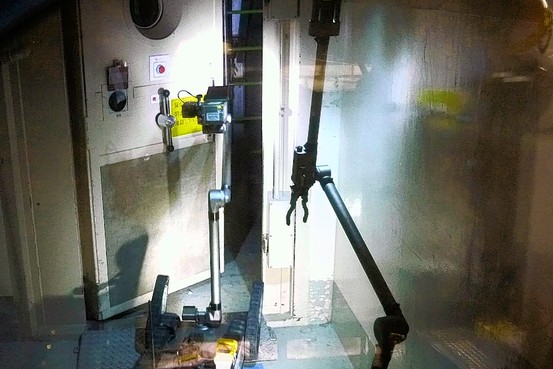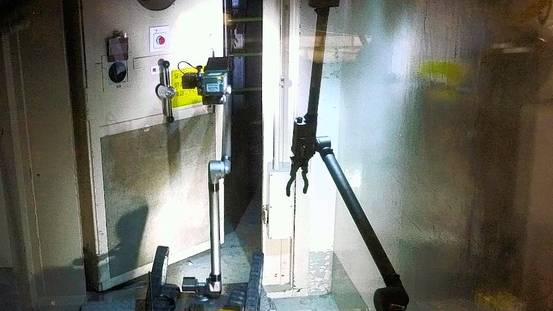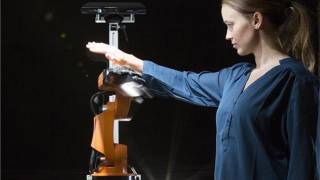Robots at Japanese reactors detect high radiation
Source: ctv.ca
Readings Monday from robots that entered two crippled buildings at Japan’s tsunami-flooded nuclear plant for the first time in more than a month displayed a harsh environment still too radioactive for workers to enter.Nuclear officials said the radiation data for Unit 1 and Unit 3 at the tsunami-flooded Fukushima Dai-ichi plant -- collected by U.S.-made robots that look like drafting lamps on treads -- do not alter plans for stabilizing the complex by year’s end under a "road map" released by the plant operator Sunday.

A remote-controlled Packbot from iRobot opens a door at a stricken reactor building at Tokyo Electric Power’s Fukushima Daiichi nucler-power complex. Tokyo Electric Power Co./Reuters
With the public growing increasingly frustrated at the slow response to the earthquake, tsunami and nuclear crises, parliament grilled Prime Minister Naoto Kan and officials from plant operator Tokyo Electric Power Co.
"You should be bowing your head in apology. You clearly have no leadership at all," Masashi Waki, a lawmaker from the opposition Liberal Democratic Party, shouted at Kan.
"I am sincerely apologizing for what has happened," Kan said, stressing that the government was doing all it could to handle the unprecedented disasters.
TEPCO’s president, Masataka Shimizu, looked visibly ill at ease as lawmakers heckled and taunted him.
Workers have not gone inside the two reactor buildings since the first days after the plant’s cooling systems were wrecked by the March 11 earthquake and tsunami. Hydrogen explosions in both buildings in the first few days destroyed their roofs and littered them with radioactive debris.
But a pair of robots, called Packbots, haltingly entered the two buildings Sunday and took readings for temperature, pressure and radioactivity. More data must be collected and radioactivity must be further reduced before workers are allowed inside, said Hidehiko Nishiyama of Japan’s Nuclear and Industrial Safety Agency.
"It’s a harsh environment for humans to work inside," Nishiyama said.
Officials said the radiation findings should not hamper the goal of achieving a cold shutdown of the plant within six to nine months as laid out in a timetable TEPCO announced Sunday. Rather, the new information would help the company in figuring out how to push ahead with the plan.
"We have expected high radioactivity inside the reactor buildings, which was confirmed by data collected by the robot," Chief Cabinet Secretary Yukio Edano said. "Even I had expected high radioactivity in those areas. I’m sure TEPCO and other experts have factored in those figures when they compiled the roadmap."
TEPCO official Takeshi Makigami said the robots must pave the way for workers to be able to re-enter the building.
"What robots can do is limited, so eventually, people must enter the buildings," Makigami said.
The robots were set to investigate Unit 2 later Monday.
As work continues inside the plant to reduce radiation levels and stem leaks into the sea, the Defense Ministry said it would send about 2,500 soldiers to join the hundreds of police, outfitted with protective suits, who are searching for bodies in tsunami debris around the plant.
Around 1,000 bodies are thought to be buried in the muddy piles of broken houses, cars and fishing boats. As of Sunday, searchers had located 66 bodies and recovered 63, police said.
The combined earthquake and tsunami have left more than 27,000 people dead or missing.
The robots being used inside the plant are made by Bedford, Massachusetts company iRobot. Traveling on miniature tank-like treads, the devices opened closed doors and explored the insides of the reactor buildings, coming back with radioactivity readings of up to 49 millisieverts per hour inside Unit 1 and up to 57 millisieverts per hour inside Unit 3.
The legal limit for nuclear workers was more than doubled since the crisis began to 250 millisieverts. The U.S. Environmental Protection Agency recommends an evacuation after an incident releases 10 millisieverts of radiation, and workers in the U.S. nuclear industry are allowed an upper limit of 50 millisieverts per year. Doctors say radiation sickness sets in at 1,000 millisieverts and includes nausea and vomiting.
The robots, along with remote controlled miniature helicopters, have enabled TEPCO to photograph and take measurements of conditions in and around the plant while minimizing the workers’ exposure to radiation and other hazards.
TEPCO’s plan for ending the crisis, drawn up at the government’s order, is meant to be a first step toward letting some of the tens of thousands of residents evacuated from the area around the company’s Fukushima Dai-ichi nuclear power plant return to their homes.
Article from: ctv.ca
Robots in Japanese Reactors Find High Radiation
Video from: YouTube.com
Scary frontier footage of Fukushima ruins, images of robots inside reactor - Raw
Video from: YouTube.com






















